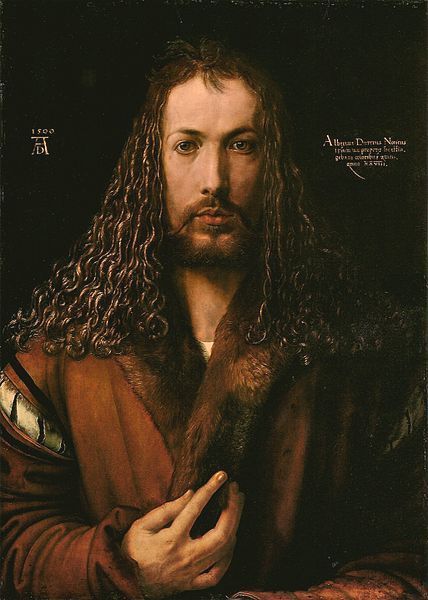Ego: The Strange and Wonderful World of Self-Portraits, BBC Four | reviews, news & interviews
Ego: The Strange and Wonderful World of Self-Portraits, BBC Four
Ego: The Strange and Wonderful World of Self-Portraits, BBC Four
A persuasive take on the unique art of an often neglected and dismissed genre
Albrecht Dürer painted himself as Jesus (pictured below). Luckily, he was blessed with the looks, the hair and the initials – echoing the geometry of his golden locks the A straddles the D in his inscribed paintings. And when this German messiah of painting died, his beguiling 1500 self-portrait – one of the most hypnotic ever painted in the history of Western art – was carried through the streets of Nuremburg, his birthplace: celebrated during his life, upon his death Dürer became a cult. A lock of that famous hair is kept at the Vienna Academy.
 It was this self-portrait that kick-started art critic Laura Cumming’s fascination with the genre as a child. Never before had she felt that a painting of a person could feel like looking at a real person. A self-portrait could, she felt, provoke just the same kinds of feelings – of discomfort, of fascination, of engagement, of infatuation, even. And though Dürer’s self-portrait – even reproduced as a postcard – rather frightened her with its intensity, she also found she was unable to stop looking. Across five centuries, Dürer exuded a quality rarely possessed by those in the flesh: charisma. No wonder he attracted a cult following.
It was this self-portrait that kick-started art critic Laura Cumming’s fascination with the genre as a child. Never before had she felt that a painting of a person could feel like looking at a real person. A self-portrait could, she felt, provoke just the same kinds of feelings – of discomfort, of fascination, of engagement, of infatuation, even. And though Dürer’s self-portrait – even reproduced as a postcard – rather frightened her with its intensity, she also found she was unable to stop looking. Across five centuries, Dürer exuded a quality rarely possessed by those in the flesh: charisma. No wonder he attracted a cult following.
Several times during this absorbing 90-minute film we could see that Cumming was visibly moved, alarmed, astonished by the various self-portraits she stood before. We could see that as she held that relic of Dürer’s hair encased in glass she couldn’t quite believe she was so near to touching it, as if she was finally being reunited with a keepsake from a long-lost love. And the wonderful thing was that, in these often heightened encounters, we were carried along with her, utterly compelled.
But not all proved to be abiding love affairs: she recoiled at the strange, gurning, and extremely disturbed and disturbing sculpted heads of Messerschmidt, the 18th-century Viennese artist who painstakingly captured in stone his contorted features in the act of exorcising the torturing “spirit of disproportion”. But she enjoyed the swagger and brio of the vainglorious Courbet; she was touched by Van Gogh's evident lack of self-pity just days after slicing his ear (with his head bandaged and from the midst of an agitated swirl of brushstrokes, he stares out with a kind of calm resolve); and by comparison, she is dismissive of that "exuberant miserabilist" Munch, seen here burning in “hell”, his image swallowed up by licking flames.
Ego: The Strange and Wonderful World of Self-Portraits was an intelligent, probing and charming visual essay and Cumming put forward a persuasive argument: that the self-portrait is quite unlike any other form of art, for it reveals the most intimate truths, including, of course, the truth of how the artist wants to be seen by the world. Moreover, the self-portrait has that “special look of looking” that is unique to the genre: the artist eyeballs us with that uniquely intense gaze – though, of course, he is not looking at us but simply scrutinising his own image in the mirror. And even as a child Cumming was acutely aware of that special intensity – and the self-portraitist’s invitation to the viewer to, as she put it, “enter into the self-awareness of the artist”. It is, she said, the self-portrait’s special gift.
Cumming clearly had no time for those professional experts and historians who insist that the “self” as individualised consciousness was only really invented in the age of the Romantics, and perfected by Freud. So she enters instead into engaging dialogues with those who are resolutely not “experts” in any trained or professional capacity. Simon Callow is wonderfully illuminating about how Rembrandt inhabited various "characters" in his self-portraits, while Julian Barnes draws us in on the rough and roguish charm of Courbet.
And through such delightfully fresh observations the viewer, too, was encouraged to enter into a renewed and compelling dialogue with the work.
- Watch Ego: The Strange and Wonderful World of Self-Portraits on BBC iPlayer
- Buy A Face to the World: On Self-Portraits by Laura Cumming on Amazon

Add comment